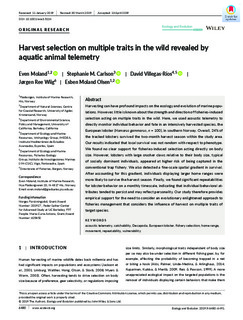| dc.description.abstract | Harvesting can have profound impacts on the ecology and evolution of marine populations. However, little is known about the strength and direction of fisheries‐induced selection acting on multiple traits in the wild. Here, we used acoustic telemetry to directly monitor individual behavior and fate in an intensively harvested species, the European lobster (Homarus gammarus, n = 100), in southern Norway. Overall, 24% of the tracked lobsters survived the two‐month harvest season within the study area. Our results indicated that local survival was not random with respect to phenotype. We found no clear support for fisheries‐induced selection acting directly on body size. However, lobsters with large crusher claws relative to their body size, typical of socially dominant individuals, appeared at higher risk of being captured in the conventional trap fishery. We also detected a fine‐scale spatial gradient in survival. After accounting for this gradient, individuals displaying larger home ranges were more likely to survive the harvest season. Finally, we found significant repeatabilities for lobster behavior on a monthly timescale, indicating that individual behavioral attributes tended to persist and may reflect personality. Our study therefore provides empirical support for the need to consider an evolutionary enlightened approach to fisheries management that considers the influence of harvest on multiple traits of target species. | nb_NO |
